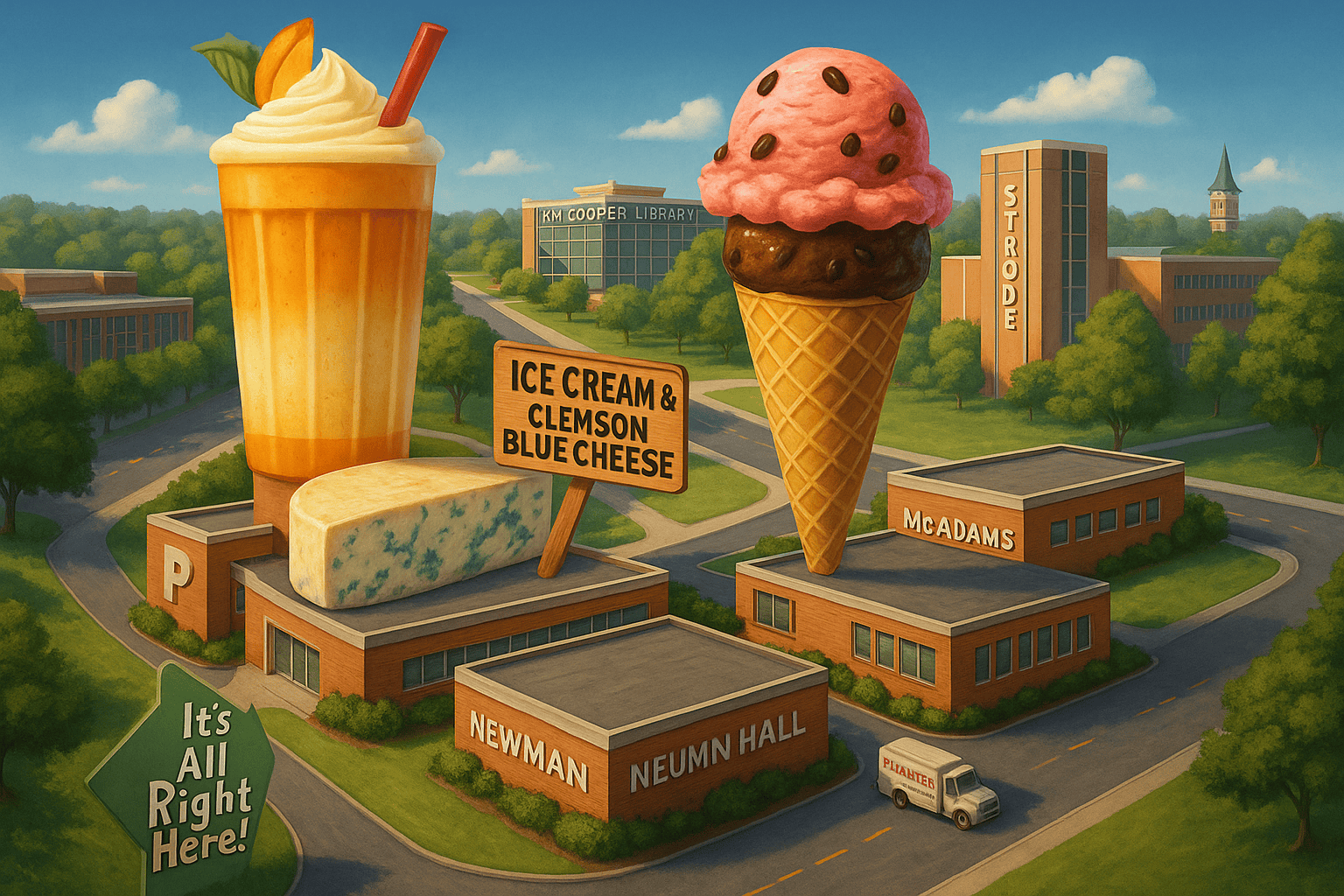A Creamy Legacy: The History of Ice Cream and Cheese at Clemson University – The Fun Bunch Version kinda
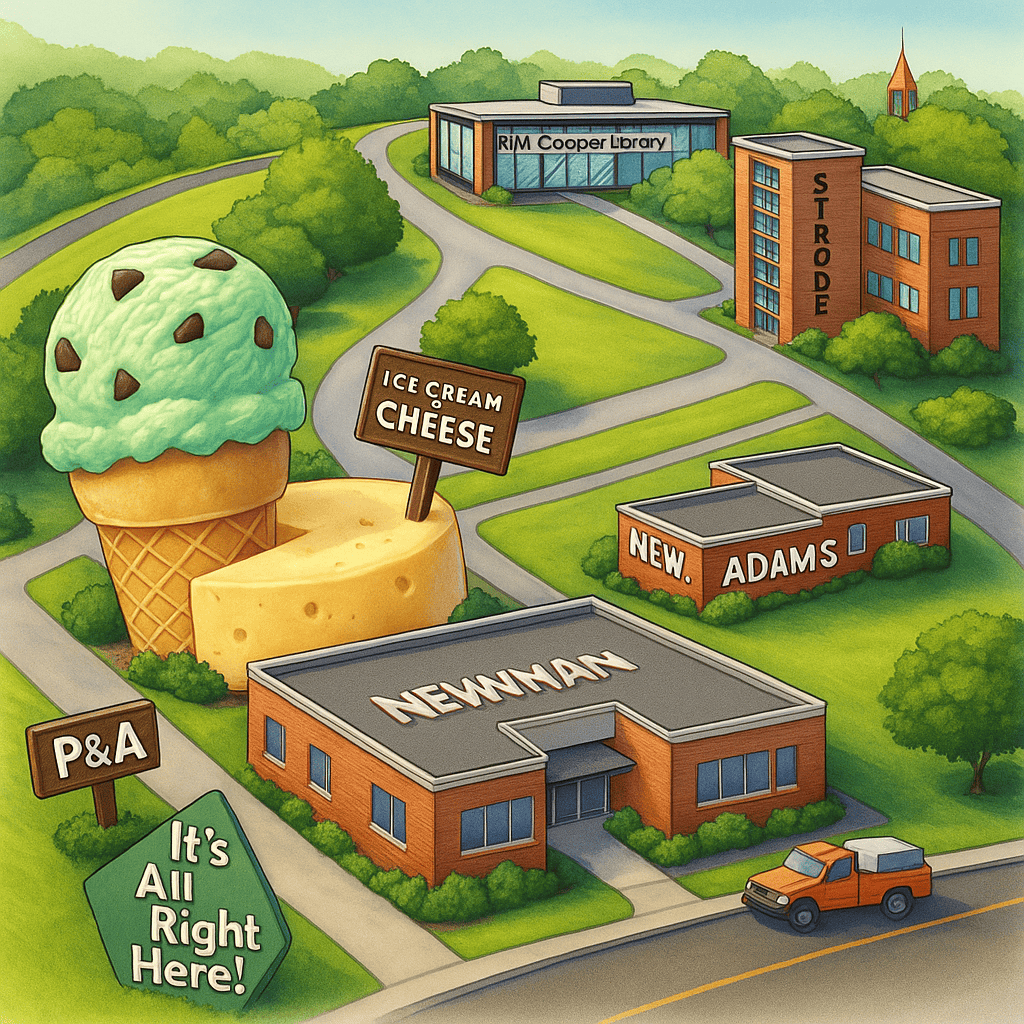
Sure, sure… Clemson blue cheese has a deep, rich history and ice cream is a beloved tradition—but let’s be real. If you were hanging around Clemson in the early ’80s like the Fun Bunch, the real MVP was the milkshake. And if you were feeling wild (or just needed the protein), you could even get ‘em to crack a raw egg in there for that extra man fuel. Rocky Balboa had nothin’ on us.
Clemson’s dairy legacy is full of flavor—literally. From the days of cows behind Sikes Hall to today’s student-run micro creamery whipping up pints of joy at the ’55 Exchange, this story’s got everything: mint chip dreams, blue cheese tunnels, and a cameo by Wisconsin (but not in a good way). Let’s not gloss over 1995 either—that year we outsourced our beloved ice cream production. Outsourced! To Wisconsin! That decision will go down in Tiger lore as a dark dairy detour. But thanks to some passionate students, alumni with sweet teeth, and a Class of ’55 gift, the good stuff is back where it belongs—on campus, in cone, and in your face.
So grab a spoon (or a straw), and enjoy this frosty journey through time. Because at Clemson, tradition doesn’t just run deep—it runs delicious.

The Milky Way: A Clemson Ice Cream & Cheese Odyssey
1904: The beginning of Clemson Ice Cream.
1965: Creamery operations moved from the original dairy building behind Sikes Hall to Newman Hall.
1995: Manufacturing of Clemson Ice Cream subcontracted to a vendor in Wisconsin.
2001: On-campus, student-run microcreamery created; ice cream production returned to Newman Hall.
2006: The ’55 Exchange retail store opened, funded by the Class of 1955.
2020: Online ordering and nationwide shipping of Clemson Ice Cream began.The 1985 T
Tiger Article – A Campus Tradition
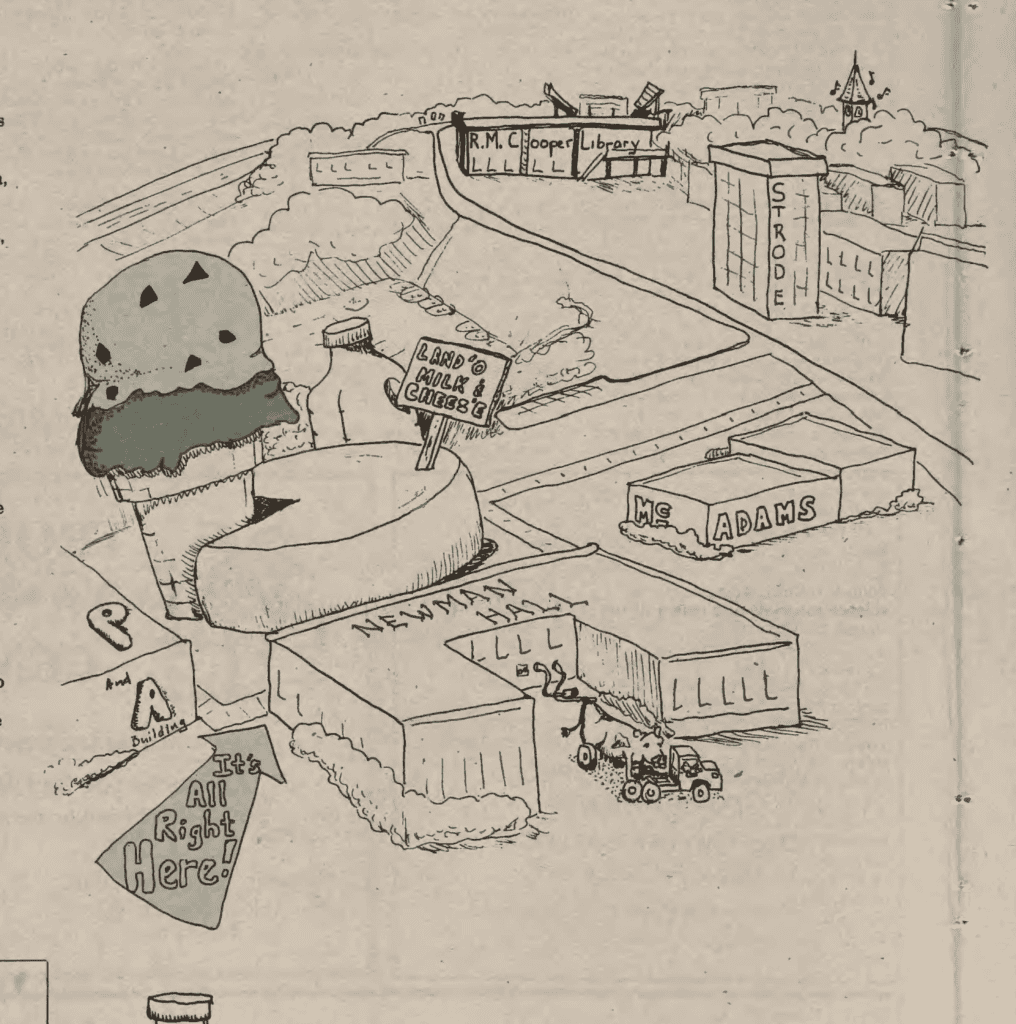
In 1985, The Tiger published a colorful account of the thriving dairy operation at Newman Hall’s Agricultural Sales Center. The story captured a unique moment in Clemson history, where ice cream flavors like orange-pineapple, butter pecan, and mint chocolate chip delighted students and alumni alike.
The Ag Sales Center was renowned not only for its flavor variety but also for its affordability and charm. Staff like Lottie Mitchell and Cliff Cartee described the center as a beloved community hub. It wasn’t just about ice cream; it was about memories, traditions, and the simple joy of a double-dip cone.
A Cheese of Distinction
Perhaps even more unique than Clemson’s ice cream is its blue cheese. This product has a storied history, beginning in 1940 with an experiment in Stumphouse Tunnel near Walhalla. Modeled after the cheese-aging caves of France, the tunnel’s 90% humidity and 56°F temperature created perfect conditions for crafting premium blue-veined cheese.
By 1958, all cheese production had moved to campus, where it continues to this day. With over 20,000 pounds produced annually, Clemson blue cheese has been shipped as far as Hawaii and Mexico and even requested by South Carolina’s governor.
Articles from The Tiger
September 6, 1985.
Stories by: Kim Norton, Foster Senn
Artwork by: John Henry
Photography by: Tim Crawford, Bryan Fortune
Dairy Delectables
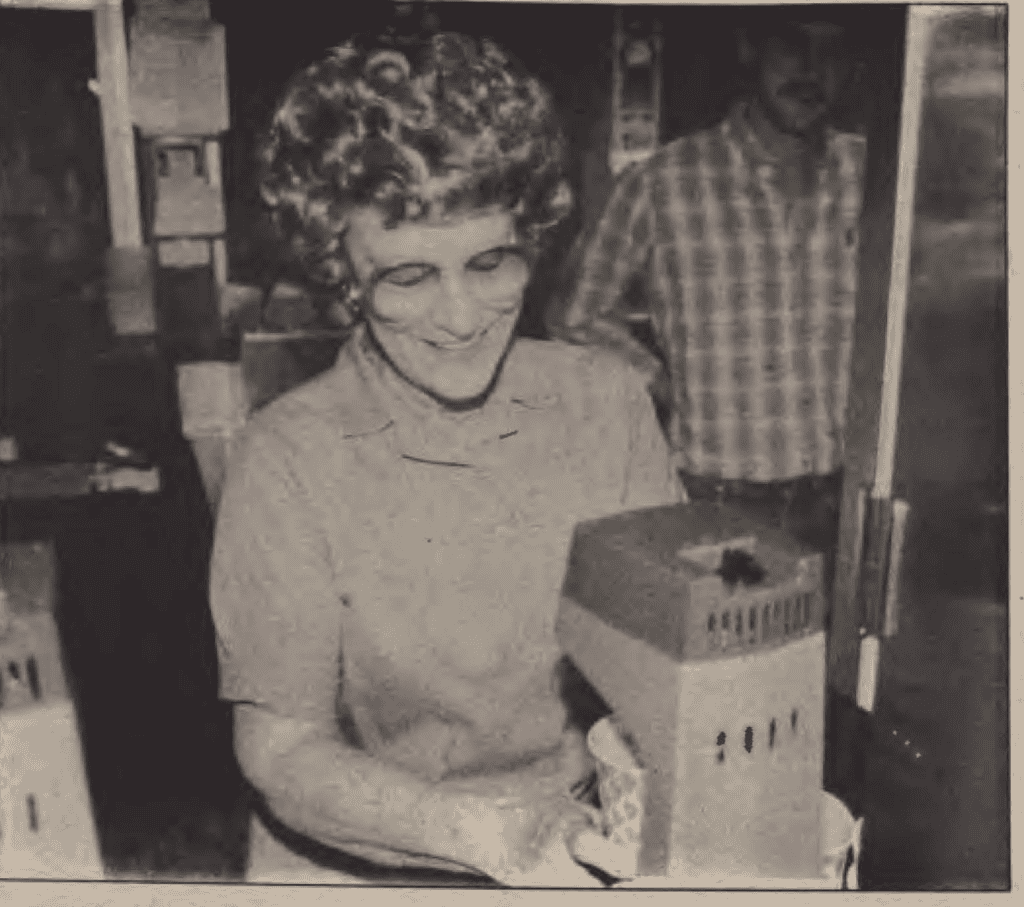
Lottie Mitchell
Tasty, traditional treats are available at Newman Hall’s Ag Sales Center
On one end of east campus-past the library, McAdams Hall, etc.-on. the first floor of Newman Hall, there’s a place that people from both far and near come to visit. It doesn’t advertise-it doesn’t need to. This place gets all the advertising it needs by word-of-mouth, like it always has.
Known and visited by many, the Agricultural Sales Center offers a variety of ice cream and other milk products. With its ice cream made on the premises, Ag. Sales’ products are one of Clemson’s most famous. Ice cream flavors available are chocolate, peach, strawberry, vanilla, orange-pineapple, lemon custard, butter pecan, cherry, coconut pineapple, chocolate-chip mint, mint, and banana. Despite the large selection, chocolate is the biggest seller by far, says Lottie Mitchell, an Ag. Sales employee

The prices for the ice creams are 55 cents for one scoop, 80 cents for two scoops, and $3 for a half-gallon. Small milkshakes are 75 cents, and sundaes and regular milkshakes are $1. The center uses basically the same recipes it always has.
The center is required to send all of its profits to state funds, says Cliff Cartee, sales manager. “But we are not here to make a profit,” he says. “We are more of an outlet for surplus.”
The milk to make the ice cream and other products comes from the University’s Dairy Barn on Cherry Road. The University cows are used in experimentation by different academic majors. The milk is sent to the dairy plant at the Ag. Sales Center where it is pasteurized. Some of the milk is then sent to the cafeterias on campus to use in daily consumption, while the rest is used for the dairy products.

Monica Kovacs
Eggs are gathered from the University’s poultry and sold at the center also. Each month the center uses more than 2,000 gallons of ice cream and makes about $18,000 a month, according to Cartee.
Ice Cream brings alumni back to campus
Great American traditions, such as baseball, hotdogs, and apple pie are still as popular today as they were when the phrase was coined many years ago.
Clemson, too, has it’s traditions one of which is the ice cream found at the Agricultural Sales Center. Some new students may be dumbfounded by the phrase, “Let’s go to the P&A building and get a milkshake.” The part about going to the P&A building is actually a fallacy because the sales center is located in Newman Hall. Regardless of it’s true location, Clemson faithfuls and newcomers seem to find their way to the often-times crowded building for some of that famous ice cream.

The shaded benches, located directly outside of the Agricultural Sales Center, provides a shady place to rest if you have “hiked” to the center from the opposite side of campus on a miserably hot day.
It’s also much safer and nicer to sit and enjoy the coolness of the ice cream if you aren’t worried about the top scoop of the double-dipped cone falling off of it’s pinnacle.
People of all ages flock to the center for their favorite flavor. Two new flavors have recently been added, mint and mint chocolate chip, to round out the total number to 11.
Customer loyalty is also a part of the center’s tradition. Lottie Mitchell said that “lots of people come here on a regular basis.” When she says regular, she means like clock-work. “Many people come here every day on their lunch hours,” Mitchell said. “Some even come more than once a day.” Football game Saturday morning are unbelievable. Mitchell couldn’t even make an estimate of the number of people who come through the doors of the center, all wanting their favorite ice cream before watching the Tigers play.
Ruth and John Auerhamer of Anderson come to Clemson quite often to sample the dairy treats offered. Mr. Auerhamer, a 1938 University graduate, comes to pick up his IPTAY tickets every year in person. “He doesn’t trust the post office with his tickets,” confided his wife.
When the Auerbamer’s come to get the football tickets, they always come to get ice cream, too. It seemed as though the ice cream was as important as the football tickets.
Beverly George, a graduate student in nursing, comes quite often to indulge herself in an
orange/pineapple milkshake. George’s daughter was the one who introduced her to the delights of the ag. center when she was a Clemson student. Since he comes to the ag. Center two or three times a week, David Gibson has had plenty of experience in sampling the ice cream. A senior now, Gibson began his ice cream habit” when he was a freshman. A banana milkshake was what Gibson chose that day but that’s not his favorite. “I get a different one every time I come here,” Gibson said.

Sharing this part of Clemson tradition with someone who is unfamiliar with it is almost like reliving your own first taste of ice cream heaven.” John Gooch, a former professor, was showing his sister, Lois Dacklewiecz from Cleveland, Ohio, the campus. As part of the tour, he took her to Newman Hall for her first double dip of butter pecan from the University. Dackiweicz was very impressed – with the town and the school but after that first lick of ice cream, you could see that the campus landscape was not on her mind “This ice cream is absolutely delicious,” she said. • Pam Carver, a part-time employee at the ag center and full-time student, said the most enjoyable part of her job serving up the ice cream is meeting people. With the number of people who come through each day it’s amazing how they remember names and faces. As Mitchell said, “Working here is quite an experience
History abounds at Ag Sales Center
Along with ice cream, the surplus milk and eggs from the ventures within the College of Agriculture are processed and sold at the Agricultural Sales Center. The eggs are packaged, and the milk is made into butter, cottage cheese, milk, buttermilk, and blue cheese. All of these are sold to the public when they are available. Of these products, the blue cheese
has the most interesting history and is the most unique, according to John Whitmire, an agricultural science associate and maker of the cheese for 13 years.

History
This product began as an experiment in 1940 when a Clemson College professor realized that Stumphouse Tunnel, just outside Walhalla, might be similar to the blue cheese tunnels in France in temperature and humidity. The tunnel, an antebellum attempt by John C. Calhoun to connect the midwest to the east coast by railroad, was abandoned due to he lack of funds during the Civil War. The abandoned project was used as a local attraction for picnics and scary. walks into darkness until the experiment began.

About $5000 was spent in clearing the tunnel of debris and adding iron gates, -a brick wall, and a cement floor at the back of the tunnel.
The tunnel, which maintains a constant 90-percent humidity level and 56-degree Fahrenheit temperature, was used-successfully until the R. F. Pool Agricultural Center was built on the campus in 1956. By 1958, all manufacturing and curing of blue vein cheese was done on campus. Now, the cheese is a popular product, according to Cliff Cartee.
Agricultural Center sales manager. ”The governor sends for the cheese occasionally, and we have mailed it as far as Hawaii and Mexico when we mailed it out. Companies would buy as many as 150 wheels at a time,” he said.

Cartee attributes the. success of the product to the lack of availability of blue veined cheese. “We are the only ones anywhere around that I know of that makes this kind of cheese,” he said “We have a sort of monopoly on it around here, and ours is good, if you like the taste of blue cheese.”
Cartee said one of the reasons – other organizations don’t produce the cheese is the cost. “It takes about 10 pounds of milk to produce one pound of cheese,” Whitmire said. It also takes a lot of storage room for it to age because it must be held in cooling rooms for six months.
Last year, the center produced 20,391 pounds of cheese from 202,240 pounds of surplus milk.
Sale
At the center, the cheese is available in wheels, wedges, and krumbles. The costs are $7.80 for a wheel. $2.50 for a wedge, $3.25 for 10 oz. krumbles, and $2.00 for 5 oz. krumbles. According to Whitmire, plenty of cheese is available this year (1985).

Whole milk is available at the store for $2.10 a gallon and lowfat for $2.05 a gallon. A half gallon of whole milk or buttermilk is $1.40. Nine-ounce containers are 24 cents. Butter, when available, is $2 a pound. This is mostly made by students for projects, Cartee said. Eggs average 80 cents per dozen, and cottage cheese is $1.25 per pound for creamy and $1.10 for dry.

The ’55 Exchange – Where Tradition Flavors the Future (and Then Some)
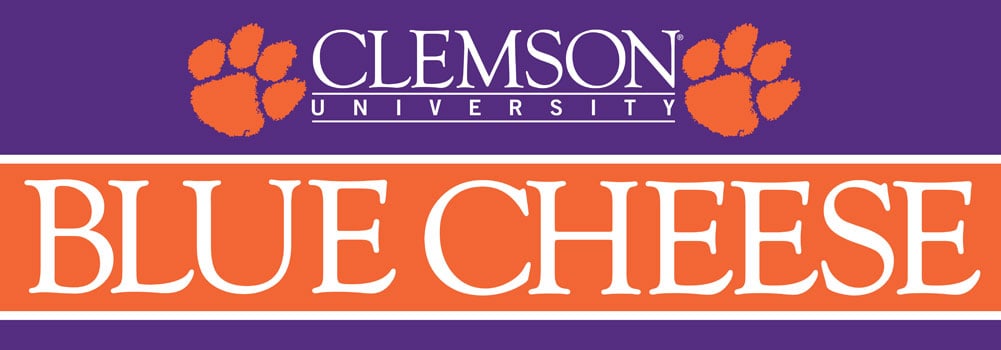
Reborn in the early 2000s with the enthusiasm of Clemson students and a generous nudge from the proud Class of 1955, the ’55 Exchange isn’t just an ice cream shop—it’s a full-blown legacy preservation machine disguised as a dessert counter. This student-run operation churns out handcrafted happiness one six-gallon batch at a time, blending nostalgia, campus pride, and just enough dairy science to make your grandma proud.
It’s not just ice cream, either—it’s Clemson culture, scooped and served. Students handle everything from inventing flavors to marketing, managing finances, and manning the counter, all while probably studying for a midterm. It’s entrepreneurship with sprinkles.
You’ll find two signature lines here:
• Wild Tiger™ – bold, adventurous flavors that pounce on your taste buds and roar sustainability, global vision, and “Let’s save some actual tigers while we’re at it.”
• Classic Original – a creamy tribute to the roots of an agricultural and mechanical school, nodding to the likes of Howard’s Rock and the legendary Great Ice Cream Military Hoax.
The ’55 Exchange doesn’t just scoop history—it scoops hope. Every bite supports student learning, leadership, and the ongoing dream that ice cream and education truly do go hand in hand.
Conclusion – The Fun Bunch Seal of Approval
Let’s call it what it is: the Clemson dairy legacy is one of the coolest stories ever told—literally. From post-war blue cheese tunnels in haunted mountains to slurping egg-thick milkshakes on the way to a psych lecture in 1983, this tale is full of flavor, tradition, and good ol’ Tiger grit.
Sure, we hit a snag in ’95 when someone had the bright idea to outsource our sweet legacy to Wisconsin (still shaking our heads). But like a good cheese, Clemson’s dairy history only got better with age. And now? The milk flows again, the machines hum at Newman, and students are mixing up magic one pint at a time.
To the current generation keeping the scoops swirling and the curds aging—we salute you. And to everyone else: grab a cone, spread the word, and never underestimate what a small college with big cows and bigger hearts can do.
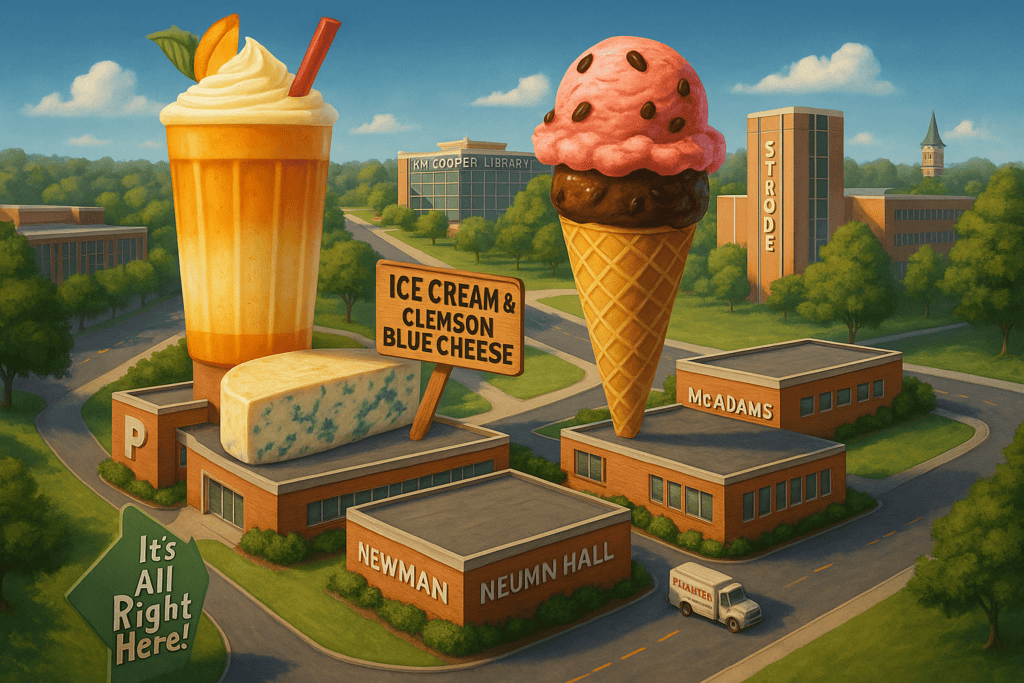
Because here at Clemson, ice cream isn’t just a treat.
It’s a tradition.
It’s a memory.
And if you’re lucky—
It comes with a raw egg.

